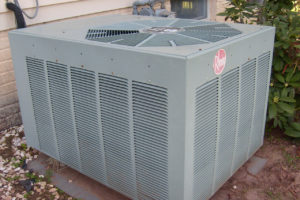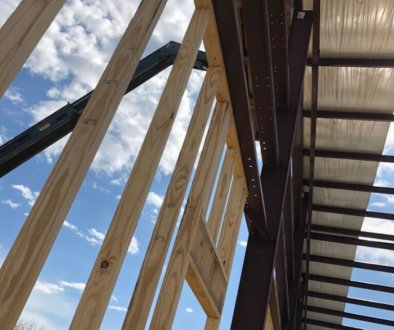 Even though over 95% of the homes in the US have an air conditioner, few people really understand even the basics of how these units’ work. Normally the only way someone would interact with their air conditioning is by adjusting the thermostat. They know enough to switch them on and set the temperature at the level they desire, but really know little about the parts that make the unit control the temperature of their home. Your air conditioner to regulate the temperature by adding or removing heat in your house. It also controls the humidity when it is removing heat.
Even though over 95% of the homes in the US have an air conditioner, few people really understand even the basics of how these units’ work. Normally the only way someone would interact with their air conditioning is by adjusting the thermostat. They know enough to switch them on and set the temperature at the level they desire, but really know little about the parts that make the unit control the temperature of their home. Your air conditioner to regulate the temperature by adding or removing heat in your house. It also controls the humidity when it is removing heat.
Do you know how it does this? Whether you are shopping for a new air conditioner or interested in learning about the one you have, the best place to start is with the general terms used to explain the functions of your unit.
BTU or British Thermal Unit:
This is way a unit’s capacity is measured. In layman’s terms it is the amount of heat that is needed to raise a pound of water by one degree of temperature. When you hear someone talk about BTUs in regards to air conditioning they are talking about the amount of heat a unit can remove from a standard sized room.
Consider 12,000 BTUs is also known as a 1 ton of cooling capacity. The higher the number of BTUs the bigger area the unit can serve. While many people think that bigger is better, when it comes to air conditioning that is not the case. It is more important to correctly match the size of the air conditioning unit with the space to be controlled.
Size Selection:
In addition to the size of the room you must consider several other issues to properly size a unit.
- Number of windows
- Size of windows
- Type of windows
- Direction windows face
- Window covering type
- Flooring type
- Wall type
- Geographical location
These items all play a role in determining the correct size unit from the cooling BTUs to the heating capacity. If the cooling portion is oversized, it will only run for very short periods of time. Short runs do not allow the unit to remove humidity from the conditioned space. You have probably been in a house or building with this problem, it feels cool and damp. It is not very comfortable and is a breeding grow for mold & mildew.
An undersized unit will not be able to keep up with changes in the outside temperature. Again you will be uncomfortable and waste money on gas and/or electricity.
EER vs SEER:
EER is a simply calculation found by dividing the BTUs into the number of running watts. Higher EER numbers indicate a more efficient system. While the higher EER unit will save you money over the long haul, it will have a higher upfront cost. In addition to reducing your annual heating and cooling cost, the higher EER also takes a step toward environmental protection by reducing your carbon foot-print and energy consumption.
The SEER adds seasonal variation and heating to the total energy picture. Some suggestion this is more accurate measurement of a unit’s efficiency.
Either way, if you select a unit with a high EER or SEER you will be helping the environment as well as reducing your energy costs for many years to come.
Fans:
There are 2 or more fans in the typical home system. One is called a supply fan, the other is called a condenser fan. Both fans work like every other fan you’ve ever seen, they move air. In the past you may recall seeing a switch on your thermostat that gave the option for the fan or auto, on or off. Most people set their fan to auto, which let the system decide when to turn the fan on. Some set the fan to on and let the fan run all the time.
Today there are variable speed fans. These have the ability to move more or less air and greatly increase the efficiency of air conditioning systems. Fans and their motors are also protected by the filter from excessive dirt.
Air Filters:
Air filters where included in the original design of air conditioning equipment to protect the equipment. The fact that air filters also protect a buildings occupant was considered a side benefit. That is until it was discovered that indoor air quality significantly impacts comfort and productivity.
Indoor air can be surprisingly dirty. In fact, several studies conducted by the EPA have shown indoor air to be substantially dirtier than the surrounding outside air, up to 100 times dirtier.
The use of a good quality air filter cannot be overstated. It will make a huge difference in the quality of your indoor air. The air you breathe should be as clean as possible, right?
The filter protects what is called the evaporator coil. This coil is commonly difficult to access making it expensive to clean. You are far better off to change your filters on a regularly scheduled basis to prevent this coil from getting dirty. Dirt on this coil will reduce the capacity of your system. That means it will need to run longer than it should, using more energy and wearing out sooner than expected.
Thermostat:
A thermostat is where you set the desired temperature of your space. It then determines when to turn your system on or off by sensing the temperature, pretty simple. They can be far more complex sensing:
- Inside temperature
- Outside temperature
- Humidity
- Calculating a collection of rooms average temperature
All of these allow a system to more accurately decide when to run your system. Years ago they offered a “Night Set Back” thermostat which was designed to save energy. Today even cheap thermostats allow you to setup a schedule of operation for every day of the week and several times per day.




